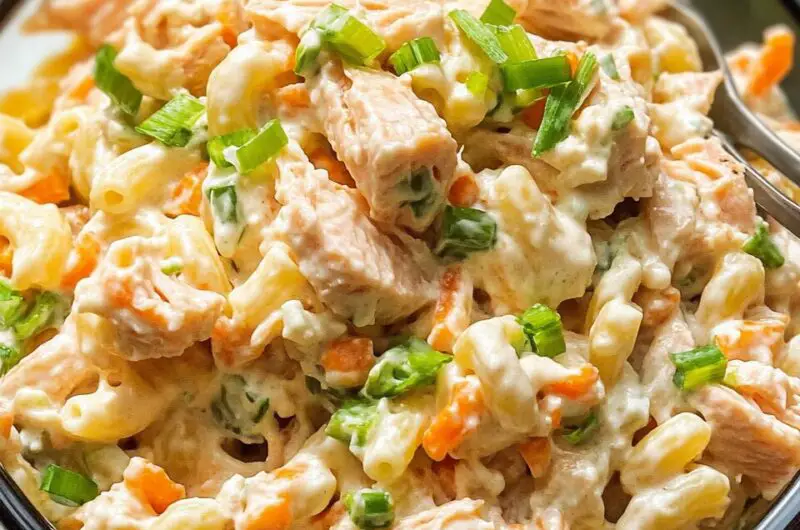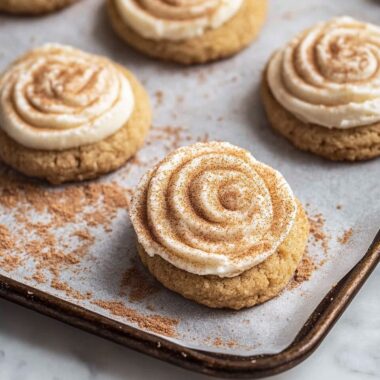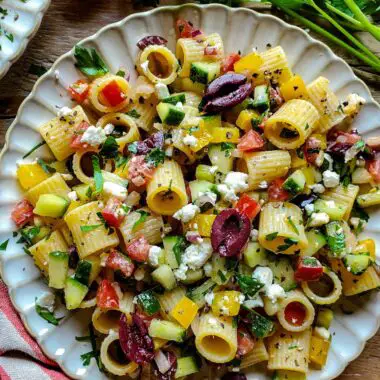This Hawaiian Tuna Mac Salad is the perfect mix of creamy, tangy, and savory. Inspired by island-style comfort food, it blends tender macaroni, flaky tuna, crunchy veggies, and a rich dressing to create a dish that’s both refreshing and filling. Whether you’re enjoying it at a summer picnic or preparing ahead for weekday lunches, it brings tropical flair to the table effortlessly. The combination of smooth mayo and sour cream is perfectly balanced by the punch of apple cider vinegar and a light hint of garlic and onion. The added crunch from celery and carrots makes each bite feel fresh and lively. It’s a dish that requires minimal effort but delivers big on flavor a true crowd-pleaser and a nostalgic nod to Hawaiian deli-style cuisine.
Full Recipe:
Ingredients:
-
2 cups elbow macaroni
-
1 (5 oz) can tuna, drained
-
1/2 cup mayonnaise
-
1/4 cup sour cream
-
1 tbsp apple cider vinegar
-
1/2 tsp garlic powder
-
1/2 tsp onion powder
-
1/2 tsp salt
-
1/4 tsp black pepper
-
1/4 cup celery, finely chopped
-
1/4 cup shredded carrots
-
2 tbsp green onions, finely chopped
-
1 tbsp sweet relish (optional)
Directions:
-
Cook macaroni according to package instructions until al dente. Drain and rinse under cold water to stop the cooking process.
-
In a large mixing bowl, combine mayonnaise, sour cream, apple cider vinegar, garlic powder, onion powder, salt, and black pepper. Mix until smooth.
-
Add the drained tuna to the bowl and flake it with a fork into the dressing.
-
Add celery, carrots, green onions, and sweet relish (if using). Mix to combine.
-
Gently fold in the cooked macaroni until evenly coated in the dressing.
-
Cover and refrigerate for at least 1 hour before serving to allow flavors to meld.
-
Serve chilled, garnished with extra green onions if desired.
Prep Time: 10 minutes | Cooking Time: 10 minutes | Total Time: 20 minutes + 1 hour chilling
Kcal: 320 kcal | Servings: 6 servings
Hawaiian Tuna Mac Salad: A Creamy Island Classic with Global Appeal
When you think of Hawaiian cuisine, your mind might wander to poke bowls, kalua pig, or maybe even a refreshing shaved ice. But nestled quietly among the vibrant flavors of the Pacific islands is a humble, creamy, and utterly comforting side dish that often flies under the radar Hawaiian Tuna Mac Salad. This seemingly simple dish holds a beloved spot in Hawaiian food culture and offers a delightful fusion of flavors that appeal far beyond the archipelago.
Whether you’re prepping for a summer cookout, potluck, or simply looking for a quick yet satisfying side dish, Hawaiian Tuna Mac Salad delivers both ease and indulgence. But behind the creamy mayo and elbow macaroni lies a fascinating culinary story worth exploring.
A Taste of Hawaiian Plate Lunch Culture
To understand the roots of tuna mac salad, you first need to understand the plate lunch, a cornerstone of contemporary Hawaiian cuisine. The plate lunch typically consists of a protein (like teriyaki chicken, loco moco, or kalbi ribs), a scoop of white rice, and a generous serving of macaroni salad. While it might sound simple, each element is crucial, and the mac salad is no exception.
Unlike other American pasta salads, Hawaiian mac salad is known for its ultra-creamy texture and slightly tangy-sweet flavor. It’s made using mayonnaise often Best Foods (the West Coast version of Hellmann’s), which is considered a gold standard in Hawaii combined with ingredients like vinegar, sugar, and a variety of mix-ins. Tuna is one such addition, transforming the salad into a more substantial and protein-rich dish.
The Role of Tuna in Hawaiian Cuisine
Tuna (or ahi, in Hawaiian) has long been a vital part of the Hawaiian diet. Traditionally eaten raw in poke or grilled over open flames, tuna is a staple that brings oceanic freshness to the islands’ culinary traditions.
Canned tuna, introduced through American and Japanese influence during the 20th century, became popular for its affordability, shelf-stability, and versatility. In a dish like tuna mac salad, it bridges the gap between convenience and flavor, adding savory depth and a dose of lean protein that elevates the salad from side dish to light meal.
Not Your Average Macaroni Salad
What makes Hawaiian-style tuna mac salad different from other pasta salads? The difference lies in both texture and flavor profile:
-
Texture: Hawaiian mac salad is intentionally soft macaroni is often cooked past al dente. This might be surprising to Italian pasta purists, but in this context, it’s all about achieving that silky mouthfeel and creamy cohesion.
-
Flavor: It balances rich mayonnaise with subtle sweetness and acidity. Ingredients like apple cider vinegar, a touch of sugar, and finely chopped veggies (such as celery, carrots, or onion) provide layers of flavor and crunch.
Adding tuna brings it all together with a salty, umami-forward punch, making each bite deeply satisfying.
Why This Dish Is Perfect for Modern Home Cooks
There’s a reason why Hawaiian Tuna Mac Salad is a favorite among home cooks: it’s quick, budget-friendly, and highly adaptable. It requires minimal cooking, can be made ahead of time, and tastes even better after chilling making it perfect for meal prepping or entertaining.
Because it uses pantry staples like elbow pasta, canned tuna, and mayo, you can whip this up even when the fridge looks sparse. You can also tweak it to your taste:
-
Add hard-boiled eggs for extra richness
-
Swap in Greek yogurt for a tangier, lighter base
-
Use whole-wheat or gluten-free pasta to suit dietary needs
-
Spice it up with a dash of hot sauce, mustard, or wasabi mayo
Its simplicity also makes it an ideal canvas for exploring flavors you can make it as traditional or as innovative as you like.
Serving Suggestions: More Than Just a Side Dish
While traditionally served as part of a plate lunch, Hawaiian Tuna Mac Salad is incredibly versatile. It can easily shine as:
-
A lunchbox hero: Pack it with greens or a piece of fruit for a quick midday meal.
-
A picnic staple: Its creamy texture holds up well in a cooler and pairs perfectly with grilled meats or sandwiches.
-
A light dinner: Pair with a bowl of miso soup or a slice of crusty bread for an easy evening bite.
-
A party favorite: Serve it in a large bowl with a sprinkle of chopped parsley or paprika for color, and watch it disappear.
Its mild, creamy flavor profile also makes it kid-friendly, and its texture and temperature make it comforting on hot or cold days alike.
Health Considerations and Tips
Like many comfort foods, Hawaiian Tuna Mac Salad is indulgent rich in fats from mayo and moderate in carbs from pasta. But with a few mindful tweaks, it can fit into a balanced diet:
-
Use light mayo or Greek yogurt to reduce fat content without sacrificing creaminess.
-
Add more veggies for fiber and nutrition think diced bell peppers, shredded cabbage, or even edamame.
-
Try whole-grain pasta for added complexity and slower-digesting carbs.
-
Drain tuna well and choose tuna packed in water instead of oil for a lighter protein source.
It’s also naturally nut-free and can be made gluten-free with pasta swaps, making it accessible for those with dietary restrictions.
Cultural Appreciation, Not Appropriation
As with many dishes rooted in multicultural histories, it’s important to approach Hawaiian Tuna Mac Salad with respect for its origins. Hawaiian cuisine is a blend of native Hawaiian ingredients and the culinary contributions of immigrants from Japan, Portugal, the Philippines, Korea, and beyond.
Mac salad, while not indigenous to Hawaii, has become part of this cultural mosaic a result of post-plantation culinary evolution. It reflects how communities adapted what they had to create something new and comforting.
So when enjoying or sharing this dish, it’s more than a creamy salad; it’s a taste of a place where cultures blend beautifully on the plate.
Conclusion:
Hawaiian Tuna Mac Salad might not be as flashy as poke or as smoky as kalua pork, but it holds a quiet power the power of nostalgia, of home, of comfort. It’s the kind of dish that reminds you of backyard BBQs, Sunday lunches, or beachside meals with family.
It’s easy to make, easier to love, and endlessly customizable. Whether you stick to the classic recipe or add your own flair, you’re partaking in a dish that carries a rich legacy from plantation roots to modern-day potlucks.








